
C Channel Roll Forming Machine An Overview
The C channel roll forming machine is a pivotal piece of equipment in the manufacturing of C-shaped steel sections. These sections are widely used in various industries, including construction, automotive, and manufacturing, due to their versatility and structural strength. This article explores the working principles, applications, and benefits of C channel roll forming machines.
Working Principles
A C channel roll forming machine operates by continuously forming flat steel strips into C-shaped profiles through a series of rollers. The process begins with feeding a flat strip of metal into the machine. As the strip moves through a series of progressive rollers, it undergoes deformation, taking on the desired C-shaped cross-section. The rollers are meticulously designed to ensure precise bending angles and dimensions.
The machine typically includes several key components a decoiler, which unwinds the coil of steel; a feeding mechanism, which aligns the metal strip; a series of forming rollers, which shape the strip; and a cutting mechanism, which trims the formed channels to the required lengths. Some advanced models may include electronic controls that enhance precision and allow for programmable adjustments, significantly improving production efficiency.
Applications
C channel sections produced by roll forming machines are essential in various applications. In the construction industry, they are used as structural supports in buildings, bridges, and other infrastructures. Their lightweight yet strong design makes them ideal for creating frameworks that require stability without excessive weight.
In the automotive sector, C channels are used for structural components, providing the necessary strength and rigidity for vehicle frameworks and chassis
. Additionally, these profiles are commonly used in the manufacturing of shelves, racks, and partitions in warehouses and industrial settings.
Benefits of C Channel Roll Forming Machines
1. Efficiency One of the primary advantages of using a C channel roll forming machine is its efficiency. The continuous process enables the production of large volumes of C channels in a relatively short time, significantly reducing labor costs and time compared to traditional fabrication methods.
2. Precision Roll forming ensures high precision in dimensions, which is crucial in applications where structural integrity is paramount. The ability to maintain consistent quality across long runs helps manufacturers meet strict tolerances and specifications.
3. Material Optimization Roll forming produces minimal waste compared to other manufacturing methods such as stamping. By utilizing the entire length of the metal strip, manufacturers can optimize material usage, resulting in cost savings and reduced environmental impact.
4. Versatility C channel roll forming machines can be adapted to produce various sizes and specifications of C channels, making them suitable for multiple projects. This versatility allows businesses to respond promptly to changing market demands.
5. Automation Modern C channel roll forming machines can be integrated with automation technology, allowing for real-time monitoring and control of production processes. This not only enhances productivity but also improves safety by minimizing manual intervention.
Conclusion
In summary, C channel roll forming machines play a crucial role in the production of C-shaped steel profiles that are vital across numerous industries. Their efficiency, precision, and versatility make them an indispensable asset for manufacturers aiming to deliver high-quality products while optimizing costs and minimizing waste. As technology advances, these machines continue to evolve, offering even greater capabilities and innovations for the future of manufacturing.